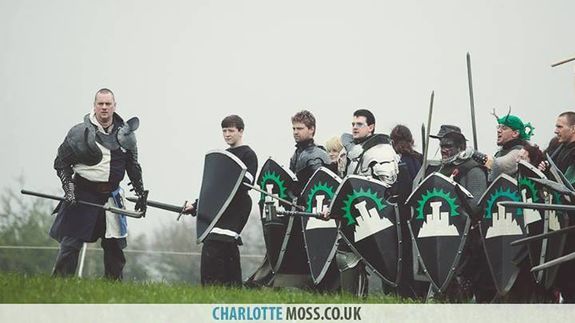Imperial army
Overview
The Empire is defended by its armies. Each army is a large force, capable of acting independently and supported by their own logistics with baggage trains, siege engines and foragers. They are therefore able to venture beyond the boundaries of the Empire and, so long as their casualties are low, remain fully capable despite being engaged in prolonged campaigns.
The typical member of an Imperial army is fed and billeted by the civil service but is not paid in coin. These volunteers have signed up for two years Imperial Service - they are trained and equipped and then assigned to an Imperial army. if they choose to leave the army at the end of that period they receive payment in land from the Empire (equivalent to a level one farm).
Although the lure of land is what draws most citizens to Imperial Service, the training and equipment received can be valuable. Most members of the many independent military units spread across the empire are former soldiers.
Army Size
To allow players to make sensible and meaningful comments about the capability of their armies, each army has a fighting strength (usually 5000). This number represents the effective fighting force of the army - equivalent to 5000 raw recruits. The civil service uses complex day magic to quantify the effective fighting force of each Imperial armies, providing this IC information to the Imperial generals. An actual Imperial army may have more or less than 5000 soldiers in it, the civil service only provide the Generals with precise information on the actual fighting strength, since this is the critical number needed to make effective strategic decisions.
Barbarian armies tend to be much larger than Imperial armies, although in practice their fighting strength is usually similar. Like the Imperial armies the fighting strength of the barbarian forces is calculated using esoteric day magic rituals.
As an army takes casualties its fighting strength drops. An army whose fighting strength falls below 1,000 (250 if it has the disciplined keyword) disbands.
Large armies
The majority of campaign armies have a maximum strength of 5,000 fighting force. A large army, however, has a maximum fighting strength of 7,500. A large army still counts as only a single campaign army. Turning an existing standard Imperial army into a large army requires a motion by the Imperial Senate, and costs 200 wains of mithril over a year (minimum 50 mithril each season until it is completed).
It is more expensive to apply keywords to a large army, or to turn a standard army with keywords into a large army.
Senate Commissions
The Imperial Senate can pass a motion to recruit a new Imperial army, or to resupply, improve, or enlarge an existing army.
Costs
- Materials: 250 mithril.
- Time: 1 year to construct
- Upkeep: 50 Thrones per season.
Recruitment
All Imperial armies must use recruits drawn from a single nation. Each nation can only physically maintain a limited number of armies at one time; this number cannot be exceeded.
When the army is complete a new Imperial title of general is created in the Imperial Military Council. Appointment follows the normal constitutional process (human generals are selected by the senators of the nation) and re-appointed each year after that.
A newly created Imperial army has no keywords, and is at its maximum strength of 5,000. It begins play mustered in one of the Imperial controlled territories belonging to the nation where it was raised.
Resupply
The strength of an Imperial army declines as it suffers casualties. While an army will slowly resupply and reinforce itself over time, the Senate can pass a motion to provide the army with additional resupply. The army to be resupplied must be in a friendly territory, and may not be engaged with any enemies.
Further details of how an Imperial army can be resupplied by the Senate can be found here.
Enlargement
The Senate can contribute resources to increase the strength of an existing campaign army, making it large. The army in question must be in an Imperial territory and not engaged with any enemies, and the process takes a year. It costs 50 wains of mithril each season until complete (for a total cost of 200 wains of mithril).
Specialization
Imperial armies have keywords that represent special abilities or situations where they are especially effective. These keywords also represent the character and flavour of the army.
The Senate can pass a motion to remove a keyword from an army - decommissioning equipment, reassigning key personnel and the like. This is free, and the Imperial army will lose the keyword over the next season.
A Senator can also raise a motion to apply a new keyword to an existing Imperial army. The army must be in a friendly territory and not engaged with an enemy. It takes six months to apply a new keyword to an army. The cost is 50 wains for the first keyword, but doubles with each subsequent keyword added:
- The first keyword applied to an army that does not already have one will cost 50 wains
- The second keyword applied to an army will cost 100 wains
- The third keyword will cost 200 wains
- Further keywords follow the same progression.
Costs are usually paid in mithril, but some keywords may require weirwood or white granite.
Upkeep
Although the soldiers in an Imperial army are not paid for their service, an army still costs a huge amount of money to operate. Each Imperial army costs 50 Thrones per season, paid for from the Imperial Senate budget. Each large army costs 75 Thrones per season. Keywords do not affect the costs to upkeep an army.
Maximum numbers of Imperial armies
The Empire cannot sustain an unlimited number of armies. In addition to the significant drain on the treasury of the Imperial Senate, each individual nation can only provide so many soldiers. The supply number for each nation represents the maximum number of Imperial armies that nation can sustain at any given time. The Senate cannot raise a new Imperial army if it would take the nation over its supply number.
The only reliable way to increase the supply number is to add additional territories to the nation in question. Likewise, the loss of territory to the barbarians may reduce the supply number for that nation.
At this time, the maximum number of armies a nation can support are as follows:
- Dawn and the Marches: 4 armies each
- Highguard, Navarr and Wintermark: 3 armies each
- The Brass Coast, the Imperial Orcs, and Varushka: 2 armies each
- The The League and Urizen 1 army each
The League would be able to support an additional army if they regain control of the territory of Holberg.
A nation will not contribute its support to maintain an army from another nation. The only way for players to increase the number of armies a nation can support is to conquer additional territory.
Military units
Some wealthy or powerful citizens maintain their own independent military unit. These units can be attached to an army to increase its effective fighting strength. This is done by the orders of the military unit’s commander (submitted using the personal resource downtime system).
The experienced and capable troops in a starting military unit provide an advantage out of proportion to their numbers, adding the equivalent to 100 raw recruits to the strength of the army they support.
Current Armies
At present there are 21 Imperial armies.
Brass Coast
Dawn
Highguard
Imperial Orcs
The League
The Marches
Urizen
Varushka
Wintermark
Further Reading
Core Brief
Additional Information
- War
- Council Address
- Appointments to the Military Council
- Appointments by the Military Council
- OOC Design

